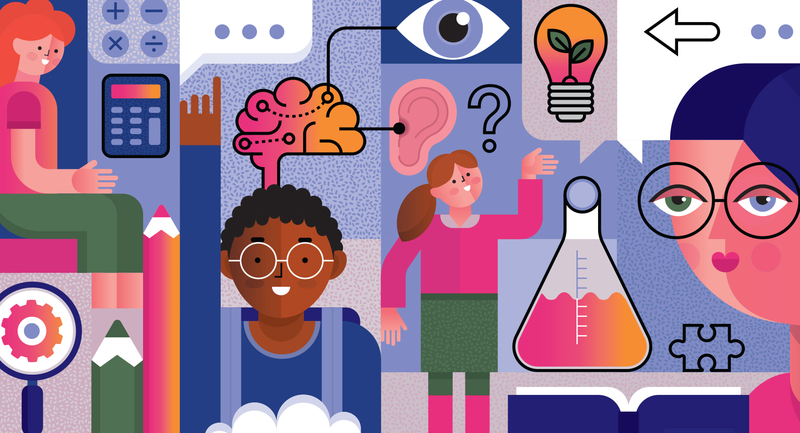Violent acts like gang-related murders, playground shootings, riots, suicides, and assaults in school are prominently featured in the news, but they aren't the norm in social interactions. Young males commit most of the physically violent acts, and 7 percent of the population commits 80 percent of all the violent acts. Thus, violence is a limited social pathology, but one that evolutionary psychologists seek to explain because of its distressing, even tragic, results. Since impulsive behavior can lead to reckless or violently aggressive behavior, we also seek to understand impulsivity. Many personal and social problems begin with an impulsive act—triggered perhaps by the aggressor's low level of self-esteem. Impulsivity, recklessness, violence—all these behaviors can negatively affect educational processes. Some recent related research developments in brain chemistry—particularly the effects of the neurotransmitter serotonin—shed light on educational practices.
Self-Esteem in a Hierarchy
Consider the following scenario —from the point of view of a neurobiologist studying social hierarchies or an evolutionary psychologist studying human behavior:A young man joins an athletic team in his freshman year of high school. He's thrilled just to make the team, even though he knows he's low in the hierarchy and won't get to play much in games. He's content for now because he also knows that the coaches and his teammates will note every successful act he makes in scrimmage, and so his playing time will come. He moves up the team hierarchy, substituting a few minutes here and there. His competition for most of this journey isn't the alpha males at the top of the hierarchy, but, rather, those who are competing with him for the next slot in the hierarchy.
Over several years, his talent and that of his teammates will determine the level he achieves. He thus may settle for four years of comradeship, scrimmage, and limited game time because he realizes that's where he properly fits in the team hierarchy; or he may eventually bask in the celebrity afforded to him as one of the stars on the team. If the latter, he may seek to begin the sequence anew in a college team, and then perhaps a pro team. If the former, his memories and friendships will have to suffice—and he will seek success in other social arenas.
But what if he believes that he rates very high compared to the others—but the coaches don't agree, and won't give him a chance to play? Perhaps it's because of something he can't control, such as his height (or by extension, gender or race or whatever defines the glass ceiling). Imagine his frustration and rage. His opportunities don't match his sense of self.
It is adaptive for a social species (like humans) to develop a system that arranges groups into reasonably compatible hierarchical arrangements to perform various group tasks. The entire group benefits if survival-related tasks are assigned to those who are generally recognized to be the most capable. But things often don't work the way we'd like them to.
The Roots of Violent Aggression
The cognitive drive to move into our expected slot in the hierarchy is so strong that many people will do whatever it takes to achieve success. To continue with our sports scenario, if the frustration becomes too intense, a person may act impulsively or recklessly for any possible chance of success—and such risk-taking may on occasion escalate into aggressive and violent acts, which we may witness in news accounts of various sports, from baseball to Olympic-level figure skating.
Evolutionary psychology argues that each success enhances the level of the neurotransmitter serotonin in the brain—and so also our motor coordination and self-esteem (see box below).
Serotonin and Prozac
Serotonin (hydroxytryptamine, or 5-HT) is a monamine neurotransmitter that enhances relaxation and smooth/controlled motor coordination (by inhibiting quick motor responses). It regulates intestinal peristalsis, cardiovascular function, endocrine secretion, mood, pain, sexual activity, appetite, and behavior and is probably (along with other neurotransmitters) involved in attention deficit disorders and seasonal affective disorder.
Serotonin is derived from the amino acid tryptophan. Wurtman found that carbohydrates in our diet enhance the entry of tryptophan into the brain, where it is converted into serotonin (Wurtman and Suffes 1996). Another neurotransmitter, nitric oxide, acts on serotonin to help curb aggressive behavior, as Nelson and colleagues (1995) found in studies with male mice.
Fluoxetine antidepressant drugs, such as Prozac, Zoloft, and Paxil, enhance the effects of serotonin. When neurotransmitters pass on their chemical message, most are then reabsorbed into the axon terminal and used again. These drugs block the reuptake channels on the terminal, and so slow down the reabsorption process (see fig.1). This means that the serotonin neurotransmitters may activate receptors several times before being reabsorbed; thus, fluoxetine drugs increase the effectiveness of a limited discharge of serotonin without actually increasing the amount.
Figure 1. Synaptic Area
Failure and negative social feedback inhibit the effects of serotonin and lead to lower self-esteem and possible violence.
When young people see no hope to rise within mainstream society, they may create their own hierarchical gang cultures that provide them with opportunities to succeed within their counterculture's mores. Those among successful people in mainstream society who decry gang symbols and exclusionary turf areas should look to the high-status symbols they use to flaunt their success and to their exclusionary golf courses and walled communities. People in both mainstream cultures and countercultures have the same biological need to succeed; they all need a positive self-concept and self-esteem. Wealthy financiers have ruined small communities by closing moderately profitable plants for even greater profits elsewhere. Are such exploitative acts any less psychologically violent to the victims than the physical violence that erupts later in such communities from those whose plummeting serotonin levels suggest no vocational hope?
Recent research on stress (Sapolsky 1994) shows that in primate groups with a developed, stable hierarchy, those at the bottom (who had little control over events) experienced far more stress and stress-related illness than those at the top. Conversely, during periods in which the hierarchical structure was unstable and shifting, those currently at the top (whose power position was threatened) experienced the most stress and stress-related illness. This finding suggests that it is in the interest of the power elite (in community and classroom) to maintain social stability, and it is in the interest of the currently disenfranchised to create as much social instability (and classroom disruption) as possible in a desperate search for respect and success.
The fewer opportunities young people have to succeed in mainstream society, the more social instability we can expect. It is in our best interest to support inclusionary policies that promote social goals and to enhance the powerful role that schools can play in helping students to seek their dreams.
Our Brain and Social Systems
Our brain's complex collections of neural networks process our cognitive activity. Several dozen neurotransmitter and hormonal systems provide the key chemical substrate of this marvelous information-processing system. Neurotransmitter molecules, which are produced within one neuron, are released from that neuron's axon terminal into the synaptic gap, where they attach to receptors on the dendrites or surface of the next neuron in the information sequence.
Recent studies with human and nonhuman primates suggest that fluctuations in the neurotransmitter serotonin play an important role in regulating our level of self-esteem and our place within the social hierarchy. Researchers associate high serotonin levels in the brain with high self-esteem and social status and low serotonin levels with low self-esteem and social status. High serotonin levels are associated with the calm assurance that leads to smoothly controlled movements, and low serotonin levels with the irritability that leads to impulsive, uncontrolled, reckless, aggressive, violent, or suicidal behavior.
Evolutionary psychologists focus on the biological underpinnings of such educationally significant concepts as self-esteem, impulsivity, and aggression and on the effects of drugs like Prozac. If genetics and fluctuations in biochemical systems combine to trigger aggression, for example, one could argue that chronically aggressive people have a reduced capacity for free will and thus are not (legally) responsible for their acts. Further, if courts mandate medical treatments for such people, the policy could be viewed as governmental mind control. The social implications of this research are profound and wide ranging. For example, in determining responsibility for an aggressive act, how important are the negative effects of the aggressor's life experiences and the events that triggered the aggression?
Wright (1995) suggests that social feedback creates fluctuations from our basal serotonin levels, and these fluctuations help determine our current level of self-esteem. Thus, serotonin fluctuations are adaptive in that they help primates to negotiate social hierarchies, to move up as far as circumstances permit, and to be reasonably content at each stage, as our earlier sports scenario suggests. Social success elevates our self-esteem (and serotonin levels), and each such elevation further raises our social expectations, perhaps to try for a promotion or leadership role we hadn't considered when we were lower on the hierarchy.
A biological system of variability in self-esteem prepares and encourages us to reach and maintain a realistic level of social status. A high or low level of self-esteem (and serotonin) isn't innate and permanent. Successful people may tumble precipitously in social status, self-esteem, and serotonin levels when they retire or are discharged and thereby may experience a rapid reduction in positive social feedback. This doesn't mean that the serotonin system developed to help low-status people endure their fate for the good of all. Evolutionary psychology argues that natural selection rarely designs things for the good of the group. But the serotonin system provides us with a way to cope in a bad social situation—to be content to play a group role that is consistent with our current limitations. The human serotonin system seems to function similarly in males and females in the important roles it plays in regulating self-esteem and impulse control.
The Role of Drugs and Nutrition
Is it possible to stimulate the serotonin system when conditions become so averse in a person's life that self-esteem and serotonin levels plummet into the depths of depression? Drugs such as Prozac (a fluoxetine antidepressant; see box on p. 76) can produce an elevation in the effects of serotonin that often enhances a person's self-esteem; this increased optimism and happier mood leads to the positive social feedback that allows the natural system to take over again in time and to function effectively. Think of jump-starting a dead car battery—a few miles of driving will reenergize the battery, and it can then function on its own.
People often use alcohol when they feel low, and alcohol does increase serotonin levels. Thus, it can temporarily help to raise our mood and self-esteem—but chronic alcohol use depletes a brain's store of serotonin, and so it makes matters even worse by further impairing the impulse control system.
Nutrition may provide another avenue to serotonin elevation. Prolonged periods of stress increase our brain's need for serotonin. Nutrition researchers have discovered a connection between serotonin/carbohydrate levels and emotionally driven eating disorders that emerge out of family stress, premenstrual syndrome, shift work, seasonal mood changes, and the decision to stop smoking. Wurtman and Suffes (1996) propose nondrug diet adaptations that could solve some of these problems.
Prescription and other drugs can provide only a temporary chemical boost in self-esteem, and diets require a certain level of self-control. The best support for a serotonin deficiency is probably the natural system of positive social feedback that we have evolved over millennia.
Educational Implications
Portfolio assessments encourage self-examination in students and enhance student self-concept and self-esteem. Journals, creative artwork, and other forms of reflective thought can produce the same results.
When students have many opportunities to work together in groups, they may experience success in both leading and supporting roles. Positive self-esteem can develop at any level in a work group, if the problem is challenging and the group values the contributions of all.
Many school conflicts arise because an impulsive, reckless act escalates into aggression. We have tended to view these events only in negative terms—as misbehavior, as something to be squashed. But what if we used positive group strategies to help students study such behavior and discover how to reduce it? David and Roger Johnson (1995) provide practical cooperative learning strategies for conflict resolution that are consistent with neurobiological research.
Emmy Werner's four-decade longitudinal study of seriously at-risk children who matured into resilient, successful adults found that they received unconditional love from family or nonfamily mentors, who encouraged their curiosity, interests, and dreams and assigned them responsibilities that helped them to discover their strengths and weaknesses (Werner and Smith 1992). We can also provide this support in the classroom—and parents, guardians, and other community members can help.
Cognitive science research is now providing some welcome biological support for practices that many educators have felt were simply right, even though these strategies take more instructional time and energy and result in less precise evaluations. Serotonin was identified as a neurotransmitter at about the time that Werner began her studies of resilient at-risk children in 1955—with no hint of the powerful biological substrate of her research. That kind of research is now becoming available to us. Let's use it.







